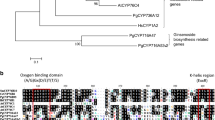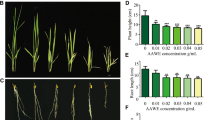Abstract
As one of the triazine herbicides with widespread usage in agriculture, metribuzin exerted nonnegligible hazardous effects on plants via excessive accumulation of reactive oxygen species and destruction of antioxidant enzymes, but the underlying harmful mechanism of metribuzin-induced oxidative damage to plants has never been exploited. Here, Arabidopsis thaliana glutathione reductase 2 (AtGR2) was employed as the biomarker to evaluate the adverse impacts of metribuzin on plants. The fluorescence intensity of AtGR2 was decreased based on the static quenching mechanism with the prediction of a single binding site toward metribuzin, and the complex formation was presumed to be mainly impelled by hydrogen bonding and van der Waals forces from the negative ΔH and ΔS. In addition, the loosened and unfolded skeleton of AtGR2 along with the increased hydrophilicity around the tryptophan residues were investigated. Besides, the glutathione reductase activity of AtGR2 was also destroyed due to structural and conformational changes. At last, the severe inhibiting growth of Arabidopsis seedling roots was discovered under metribuzin exposure. Hence, the evaluation of the molecular interaction mechanism of AtGR2 with metribuzin will establish valuable assessments of the toxic effects of metribuzin on plants.





Similar content being viewed by others
Data availability
All data generated or analyzed during this study are included in this published article.
References
Almeida AC, Gomes T, Langford K, Thomas KV, Tollefsen KE (2019) Oxidative stress potential of the herbicides bifenox and metribuzin in the microalgae Chlamydomonas reinhardtii. Aquat Toxicol 210:117–128
Antonopoulou M, Konstantinou I (2014) Photocatalytic treatment of metribuzin herbicide over TiO2 aqueous suspensions: removal efficiency, identification of transformation products, reaction pathways and ecotoxicity evaluation. J Photochem Photobio A Chem 294:110–120
Ariga GG, Naik PN, Chimatadar SA, Nandibewoor ST (2016) Interactions between epinastine and human serum albumin: Investigation by fluorescence, UV–vis, FT–IR, CD, lifetime measurement and molecular docking. J Mol Struct 1137:485–494
Battaglino B, Grinzato A, Pagliano C (2021) Binding properties of photosynthetic herbicides with the Q site of the D1 protein in plant photosystem II: a combined functional and molecular docking study. Plants (Basel, Switzerland) 10(8):1501
Cara IG, Trinca LC, Trofin AE, Cazacu A, Topa D, Peptu CA, Jitareanu G (2015) Assessment of some straw-derived materials for reducing the leaching potential of Metribuzin residues in the soil. Appl Surf Sci 358(13):586–594
Chi Z, Liu R (2012) New insights into the characterization of the binding of tetracycline analogues with lysozyme: a biophysical study. Chemosphere 86(1):92–97
Cohen A, Hacham Y, Welfe Y, Khatib S, Avice JC, Amir R (2020) Evidence of a significant role of glutathione reductase in the sulfur assimilation pathway. Plant J 102(2):246–261
Das K, Roychoudhury A (2014) Reactive oxygen species (ROS) and response of antioxidants as ROS-scavengers during environmental stress in plants. FrontEnviron Sci 2(53):53
de Barros ALC, da Silva Rodrigues DA, da Cunha CCRF, Chagas IASD, Santo DRDE, Silva SQ, Afonso RJCF (2021) Aqueous chlorination of herbicide metribuzin: identification and elucidation of “new” disinfection by-products, degradation pathway and toxicity evaluation. Water Res 189:116545
Diamanti-Kandarakis E, Bourguignon J, Giudice L, Hauser R, Prins G, Soto A, Zoeller R, Gore A (2009) Endocrine-disrupting chemicals: an Endocrine Society scientific statement. Endocr Rev 30(4):293–342
Diyanat M, Saeidian H (2019) The metribuzin herbicide in polycaprolactone nanocapsules shows less plant chromosome aberration than non-encapsulated metribuzin. EnvironChem Lett 17(10):1881–1888
Fairchild JF, Sappington LC (2002) Fate and effects of the triazinone herbicide metribuzin in experimental pond mesocosms. Arch Environ Contam Toxicol 43(2):198–202
Fu Z, Tang SF, Hou X (2020) Probing the molecular toxic mechanism of di-(2-ethylhexyl) phthalate with glutathione transferase Phi8 from Arabidopsis thaliana. Int J Biol Macromol 145:165–172
Guimarães ACD, Mendes KF, Dos Reis FC, Campion TF, Christoffoleti PJ, Tornisielo VL (2018) Role of soil physicochemical properties in quantifying the fate of diuron, hexazinone, and metribuzin. Environ Sci Pollut Res Int 25(13):12419–12433
Höger GA, Wiegand M, Worbs B, Diederichsen U (2020) Membrane-associated nucleobase-functionalized β-peptides (β-PNAs) affecting membrane support and lipid composition. Chembiochem. 21(18):2599–2603
Hadichegeni S, Goliaei B, Taghizadeh M, Davoodmanesh S, Taghavi F, Hashemi M (2018) Characterization of the interaction between human serum albumin and diazinon via spectroscopic and molecular docking methods. Hum Exp Toxicol 37(9):959–971
Hao F, Jing M, Zhao X, Liu R (2015) Spectroscopy, calorimetry and molecular simulation studies on the interaction of catalase with copper ion. Journal of photochemistry and photobiology. J Photochem Photobiol B, Biol 143:100–106
Hardt WD, Schlegl J, Erdmann VA, Hartmann RK (1995) Kinetics and thermodynamics of the RNase P RNA cleavage reaction: analysis of tRNA 3'-end variants. J Mol Biol 247(2):161–172
Honório M, Junior E, Moreira R, Sena R, José H (2013) Removal of metribuzin by ozonation: effect of initial concentration and pH. J Environ Prot 4(6):564–569
Hostovsky M, Blahova J, Plhalova L, Stepanova S, Praskova E, Marsalek P, Svobodova Z (2012) Oxidative stress parameters in early developmental stages of common carp (Cyprinus carpio L.) after subchronic exposure to terbuthylazine and metribuzin. Neuro Endocrinol Lett 33:124–129
Husak VV, Mosiichuk NM, Maksymiv IV, Storey JM, Storey KB, Lushchak VI (2016) Oxidative stress responses in gills of goldfish, Carassius auratus, exposed to the metribuzin-containing herbicide Sencor. Environ Toxicol Pharmacol 45:163–169
Ju P, Zhang Y, Zheng Y, Gao F, Jiang F, Li J, Sun C (2020) Probing the toxic interactions between polyvinyl chloride microplastics and Human Serum Albumin by multispectroscopic techniques. Sci Total Environ 734:139219
Kavitha P, Rao JV (2007) Oxidative stress and locomotor behaviour response as biomarkers for assessing recovery status of mosquito fish, Gambusia affinis after lethal effect of an organophosphate pesticide, monocrotophos. Pestic Biochem Physiol 87(2):182–188
Kocaoğlu E, Talaz O, Çavdar H, Şentürk M, Supuran CT, Ekinci D (2019) Determination of the inhibitory effects of N-methylpyrrole derivatives on glutathione reductase enzyme. J Enzyme Inhib Med Chem 34(1):51–54
Lakowicz JR (2006) Principles of Fluorescence Spectroscopy, 3rd edn. Springer, New York, pp 277–285
Liu HJ, Wang X, Yang ZL, Ren LL, Qian TT (2020) Identification and biochemical characterization of the glutathione reductase family from Populus trichocarpa. Plant Sci 294:110459
Marty L, Bausewein D, Müller C, Bangash SAK, Moseler A, Schwarzländer M, Müller-Schüssele SJ, Zechmann B, Riondet C, Balk J, Wirtz M, Hell R, Reichheld JP, Meyer AJ (2019) Arabidopsis glutathione reductase 2 is indispensable in plastids, while mitochondrial glutathione is safeguarded by additional reduction and transport systems. New Phytol 224(4):1569–1584
Mehdizadeh M, Izadi-Darbandi E, Yazdi M, Rastgoo M, Nassirli H (2019) Impacts of different organic amendments on soil degradation and phytotoxicity of metribuzin. Int J Recycl Organic Waste Agric 8(1):113–121
Pai EF, Schulz GE (1983) The catalytic mechanism of glutathione reductase as derived from x-ray diffraction analyses of reaction intermediates. J Biol Chem 258(3):1752–1757
Pan B, Han X, Wu M, Peng H, Zhang D, Li H, Xing B (2012) Temperature dependence of ofloxacin fluorescence quenching and complexation by Cu(II). Environ Pollut 171:168–173
Piao X, Liu Z, Li Y, Yao D, Sun L, Wang B, Ma Y, Wang L, Zhang Y (2019) Investigation of the effect for bisphenol A on oxidative stress in human hepatocytes and its interaction with catalase. Spectrochim Acta A Mol Biomol Spectrosc 221:117149
Puchalski MM, Morra MJ, Wandruszka RV (1991) Assessment of inner filter effect corrections in fluorimetry. Fresenius J Anal Chem 340(6):341–344
Quan XP, Sun ZQ, Xu JL, Liu SY, Han YD, Xu Y, Meng H, Wu J, Zhang X (2020) Construction of an aminated MIL-53(Al)-functionalized carbon nanotube for the efficient removal of bisphenol AF and metribuzin. Inorg Chem 59(5):2667–2679
Rahman AJ, Sharma D, Kumar D, Pathak M, Singh A, Kumar V, Chawla R, Ojha H (2021) Spectroscopic and molecular modelling study of binding mechanism of bovine serum albumin with phosmet. Spectrochim Acta A Mol Biomol Spectrosc 244:118803
Ross P, Subramanian S (1981) Thermodynamics of protein association reactions: forces contributing to stability. Biochemistry 20(11):3096–3102
Salam S, Iqbal Z, Khan AA, Mahmood R (2021) Oral administration of thiram inhibits brush border membrane enzymes, oxidizes proteins and thiols, impairs redox system and causes histological changes in rat intestine: a dose dependent study. Pestic Biochem Physiol 178:104915
Sikanyika M, Aragão D, Mcdevitt CA, Maher MJ (2019) The structure and activity of the glutathione reductase from Streptococcus pneumonia. Acta Crystallo Section F: Struct Biol Communicat 75(1):54–61
Solomando A, Capó X, Alomar C, Compa M, Valencia JM, Sureda A, Deudero S (2021) Assessment of the effect of long-term exposure to microplastics and depuration period in Sparus aurata Linnaeus, 1758: Liver and blood biomarkers. Sci Total Environ 786:147479
Štěpánová S, Doleželová P, Plhalová L, Prokeš M, Maršálek P, Škorič M, Svobodová Z (2012) The effects of metribuzin on early life stages of common carp (Cyprinus carpio). Pestic Biochem Physiol 103(2):152–158
Stoddard EG, Killinger BJ, Nag SA, Martin J, Corley R, Smith JN, Wright AT (2019) Benzo[ a] pyrene induction of glutathione S-transferases: an activity-based protein profiling investigation. Chem Res Toxicol 32(6):1259–1267
Travlos IS, Gkotsi T, Roussis I, Kontopoulou CK, Kakabouki I, Bilalis DJ (2017) Effects of the herbicides benfluralin, metribuzin and propyzamide on the survival and weight of earthworms (Octodrilus complanatus). Plant Soil Environ 63(3):117–124
Volova T, Demidenko A, Kurachenko N, Baranovsky S, Petrovskaya O, Shumilova A (2021) Efficacy of embedded metribuzin and tribenuron-methyl herbicides in field-grown vegetable crops infested by weeds. Environ Sci Pollut Res Int 28(1):982–994
Wang J, Wang J, Song W, Yang X, Zong W, Liu R (2016) Molecular mechanism investigation of the neutralization of cadmium toxicity by transferrin. Physical Chem Chem Physics : PCCP 18(5):3536–3544
Xie Y, Hou X (2021) Molecular assessment of the toxic mechanism of the latest neonicotinoid dinotefuran with glutathione peroxidase 6 from Arabidopsis thaliana. J Agric Food Chem 69(2):638–645
You AS, Jeong MH, Lee JB, Park YK, Shin JS, Park KH (2008) Thyroid hormone-like activity of metribuzin as a endocrine disruptor in rats and HeLaTRE cell culture. Korea J Pestic Sci 12(4):342–350
Yu X, Pasternak T, Eiblmeier M, Ditengou F, Kochersperger P, Sun J, Wang H, Rennenberg H, Teale W, Paponov I, Zhou W, Li C, Li X, Palme K (2013) Plastid-localized glutathione reductase2-regulated glutathione redox status is essential for Arabidopsis root apical meristem maintenance. Plant Cell 25(11):4451–4468
Zeng HJ, Qi T, Yang R, You J, Qu LB (2014) Spectroscopy and molecular docking study on the interaction behavior between nobiletin and pepsin. J Fluoresc 24(4):1031–1040
Zhang T, Zhang H, Liu G, Gao C, Liu R (2014) Interaction of Cu(2+), Pb (2+), Zn (2+) with trypsin: what is the key factor of their toxicity? J Fluoresc 24(6):1803–1810
Funding
The research was supported by the National Natural Science Foundation of China (No. 32170172) and the Natural Science Foundation of Shandong province (ZR2020MC052).
Author information
Authors and Affiliations
Contributions
Material preparation was carried out by Dongmei Xiang and Lin Zhu. Data collection was performed by Dongmei Xiang. Experiment design and data analysis were performed by Xiaomin Hou and Song Yang. The first draft of the manuscript was written by Dongmei Xiang and Xiaomin Hou. All authors read and approved the final manuscript.
Corresponding author
Ethics declarations
Ethics approval and consent to participate
Not applicable.
Consent for publication
Not applicable.
Competing interests
The authors declare no competing interests.
Additional information
Responsible Editor: Gangrong Shi
Publisher’s note
Springer Nature remains neutral with regard to jurisdictional claims in published maps and institutional affiliations.
Supplementary information
Rights and permissions
Springer Nature or its licensor holds exclusive rights to this article under a publishing agreement with the author(s) or other rightsholder(s); author self-archiving of the accepted manuscript version of this article is solely governed by the terms of such publishing agreement and applicable law.
About this article
Cite this article
Xiang, D., Zhu, L., Yang, S. et al. Scrutinizing the interaction between metribuzin with glutathione reductase 2 from Arabidopsis thaliana: insight into the molecular toxicity in agriculture. Environ Sci Pollut Res 30, 11936–11945 (2023). https://doi.org/10.1007/s11356-022-22808-0
Received:
Accepted:
Published:
Issue Date:
DOI: https://doi.org/10.1007/s11356-022-22808-0





